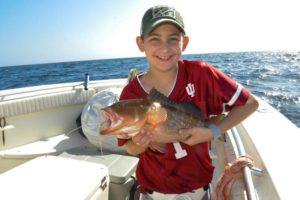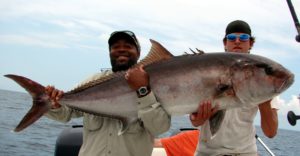Have you ever wondered why regulations like size limits, seasons, and bag limits are set the way they are? In this series of articles, we’ll explore the logic used to set fishing regulations. We’ll explain why these types of regulations vary by species and explore the factors that are considered when we set them.
Minimum size limits are set for nearly all commercially and recreationally important species we manage. When we set a minimum size limit, we try to allow a fish to spawn at least once before it grows large enough to be harvested. This is typically measured with an estimate of the percentage of female fish that reach sexual maturity at a certain length. We rarely set a minimum size limit lower than the size at which 50% of females are sexually mature. When setting a minimum size limit for each sector, we also consider what size will allow us to catch the largest amount of fish while also allowing the stock to replace those fish each year.
Not surprisingly, there are many factors beyond size at sexual maturity that need to be considered when setting a minimum size limit. Discard mortality, stock status, special biological considerations, and harvest rates all influence minimum size limit decisions. In this article, we’ll take a look at a few species-specific examples to highlight the different influences that impact minimum size limit decisions:
Discard Mortality:
 The number of fish thrown back dead increases as the minimum size limit increases. For example, half of female red grouper are estimated to be sexually mature when they’re about 11 inches total length. However, the commercial minimum size limit for red grouper is set at 18 inches total length, and the recreational limit is set at 20 inches total length. Both sectors minimum size limits exceed the red grouper length at which half of females reach sexual maturity. In this case, the minimum size limit for the different fishing sectors is based balancing discard mortality with maximizing each fish’s opportunitie
The number of fish thrown back dead increases as the minimum size limit increases. For example, half of female red grouper are estimated to be sexually mature when they’re about 11 inches total length. However, the commercial minimum size limit for red grouper is set at 18 inches total length, and the recreational limit is set at 20 inches total length. Both sectors minimum size limits exceed the red grouper length at which half of females reach sexual maturity. In this case, the minimum size limit for the different fishing sectors is based balancing discard mortality with maximizing each fish’s opportunitie
s to spawn. Commercial fishing methods for red grouper, which includes using bottom longlines, have a higher discard mortality rate than recreational fishing. The commercial sector also regularly catches larger red grouper than the recreational sector. Both sectors are managed with an annual catch target (quota), but setting the commercial minimum size limit smaller than the recreational limit creates the best balance between allowing the fish to
reproduce before being harvested while also reducing dead discards in the commercial fishery.
Stock Status:
 Greater amberjack has been overfished and subject to a rebuilding plan for over a decade. The greater amberjack commercial minimum size limit is 36 inches fork length, and the recreational minimum size limit is 34 inches fork length. Approximately 45% of females are sexually mature at 32 inches, 85% are mature at 34 inches, and 97% are mature at 36 inches. The Council decided to established a recreational minimum size limit of 34inches FL for greater amberjack since they have a relatively low discard morality rate. This allows for a greater amount of spawning to help rebuild the stock faster.
Greater amberjack has been overfished and subject to a rebuilding plan for over a decade. The greater amberjack commercial minimum size limit is 36 inches fork length, and the recreational minimum size limit is 34 inches fork length. Approximately 45% of females are sexually mature at 32 inches, 85% are mature at 34 inches, and 97% are mature at 36 inches. The Council decided to established a recreational minimum size limit of 34inches FL for greater amberjack since they have a relatively low discard morality rate. This allows for a greater amount of spawning to help rebuild the stock faster.
Special Biological Considerations:
 Fifty percent t of female hogfish are estimated to be sexually mature between 6- and 7.5-inches fork length. Despite this, we recently raised the minimum size limit from 12 to 14 inches fork length. This decision was based on two things: First, when fish first reach sexual maturity, they are less reproductively successful than more mature fish. Second, hogfish spawn in harems (one male is responsible for fertilizing the eggs of many females) and they’re hermaphrodites (all hogfish begin life as females, then transition to males as they grow older based on social cues). So, while they reach sexual maturity as females at a relatively small size, they’re about 16.5 inches before half of the females transition to male. In this case, since fewer males are required to sustain a healthy spawning population, increasing the minimum size limit protects spawning females by shifting harvest so it favors males. It also allows fish to age so they can grow to be more reproductively successful before they can be harvested.
Fifty percent t of female hogfish are estimated to be sexually mature between 6- and 7.5-inches fork length. Despite this, we recently raised the minimum size limit from 12 to 14 inches fork length. This decision was based on two things: First, when fish first reach sexual maturity, they are less reproductively successful than more mature fish. Second, hogfish spawn in harems (one male is responsible for fertilizing the eggs of many females) and they’re hermaphrodites (all hogfish begin life as females, then transition to males as they grow older based on social cues). So, while they reach sexual maturity as females at a relatively small size, they’re about 16.5 inches before half of the females transition to male. In this case, since fewer males are required to sustain a healthy spawning population, increasing the minimum size limit protects spawning females by shifting harvest so it favors males. It also allows fish to age so they can grow to be more reproductively successful before they can be harvested.
Harvest Rate:

Gray triggerfish first reach sexual maturity at 10 inches fork length. The commercial minimum size is 14 inches, and the recreational minimum size limit is 15 inches. Gray triggerfish are no longer designated overfished but are still in a rebuilding plan. Male gray triggerfishare significantly larger than females. While the larger minimum size limit does benefit the stock by allowing more spawning before harvest, we recently increased the recreational size limit for a different reason. Recreational seasons for gray triggerfish have become shorter and fisheries managers wanted tomaximize the number of days open for anglers to try to catch gray triggerfish. In this case, since gray triggerfish are managed with annual catch target (quota), the season can only be extended by slowing the rate of harvest. This can be done by increasing the minimum size limit or reducing the bag limit. Since the gray triggerfish bag limit is already 1-per person per day, the minimum size limit was increased to 15 inches in an effort to keep the recreational season open longer.
While the goal of setting a minimum size limit is to allow a fish to spawn at least once before being harvested, there are many other factors that can influence the decision. Each species requires its own unique management strategy based on biological characteristics, stock condition, and the methods used by anglers to target them. Deciding when, how, and what types of regulations to set for different species can be very complex. Finding a balance between conservation, fishing opportunity, and flexibility for anglers can be daunting. This is why it is critical for managers and stakeholders to work together in the regulatory process.

